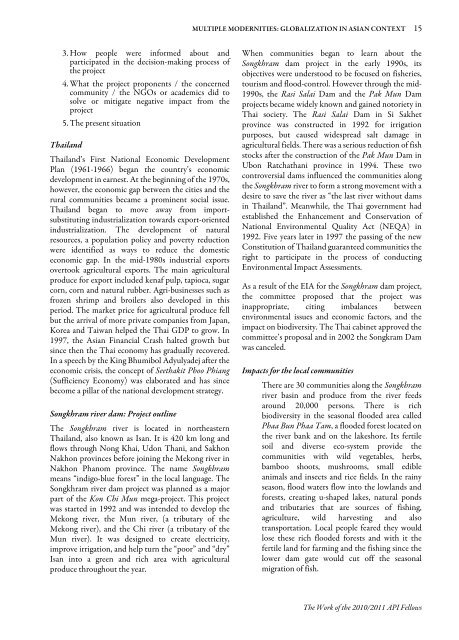Untitled - Api-fellowships.org
Untitled - Api-fellowships.org
Untitled - Api-fellowships.org
You also want an ePaper? Increase the reach of your titles
YUMPU automatically turns print PDFs into web optimized ePapers that Google loves.
MULTIPLE MODERNITIES: GLOBALIZATION IN ASIAN CONTEXT153. How people were informed about andparticipated in the decision-making process ofthe project4. What the project proponents / the concernedcommunity / the NGOs or academics did tosolve or mitigate negative impact from theproject5. The present situationThailandThailand’s First National Economic DevelopmentPlan (1961-1966) began the country’s economicdevelopment in earnest. At the beginning of the 1970s,however, the economic gap between the cities and therural communities became a prominent social issue.Thailand began to move away from importsubstitutingindustrialization towards export-orientedindustrialization. The development of naturalresources, a population policy and poverty reductionwere identified as ways to reduce the domesticeconomic gap. In the mid-1980s industrial exportsovertook agricultural exports. The main agriculturalproduce for export included kenaf pulp, tapioca, sugarcorn, corn and natural rubber. Agri-businesses such asfrozen shrimp and broilers also developed in thisperiod. The market price for agricultural produce fellbut the arrival of more private companies from Japan,Korea and Taiwan helped the Thai GDP to grow. In1997, the Asian Financial Crash halted growth butsince then the Thai economy has gradually recovered.In a speech by the King Bhumibol Adyulyadej after theeconomic crisis, the concept of Seethakit Phoo Phiang(Sufficiency Economy) was elaborated and has sincebecome a pillar of the national development strategy.Songkhram river dam: Project outlineThe Songkhram river is located in northeasternThailand, also known as Isan. It is 420 km long andflows through Nong Khai, Udon Thani, and SakhonNakhon provinces before joining the Mekong river inNakhon Phanom province. The name Songkhrammeans “indigo-blue forest” in the local language. TheSongkhram river dam project was planned as a majorpart of the Kon Chi Mun mega-project. This projectwas started in 1992 and was intended to develop theMekong river, the Mun river, (a tributary of theMekong river), and the Chi river (a tributary of theMun river). It was designed to create electricity,improve irrigation, and help turn the “poor” and “dry”Isan into a green and rich area with agriculturalproduce throughout the year.When communities began to learn about theSongkhram dam project in the early 1990s, itsobjectives were understood to be focused on fisheries,tourism and flood-control. However through the mid-1990s, the Rasi Salai Dam and the Pak Mun Damprojects became widely known and gained notoriety inThai society. The Rasi Salai Dam in Si Sakhetprovince was constructed in 1992 for irrigationpurposes, but caused widespread salt damage inagricultural fields. There was a serious reduction of fishstocks after the construction of the Pak Mun Dam inUbon Ratchathani province in 1994. These twocontroversial dams influenced the communities alongthe Songkhram river to form a strong movement with adesire to save the river as “the last river without damsin Thailand”. Meanwhile, the Thai government hadestablished the Enhancement and Conservation ofNational Environmental Quality Act (NEQA) in1992. Five years later in 1997 the passing of the newConstitution of Thailand guaranteed communities theright to participate in the process of conductingEnvironmental Impact Assessments.As a result of the EIA for the Songkhram dam project,the committee proposed that the project wasinappropriate, citing imbalances betweenenvironmental issues and economic factors, and theimpact on biodiversity. The Thai cabinet approved thecommittee’s proposal and in 2002 the Songkram Damwas canceled.Impacts for the local communitiesThere are 30 communities along the Songkhramriver basin and produce from the river feedsaround 20,000 persons. There is richbiodiversity in the seasonal flooded area calledPhaa Bun Phaa Tam, a flooded forest located onthe river bank and on the lakeshore. Its fertilesoil and diverse eco-system provide thecommunities with wild vegetables, herbs,bamboo shoots, mushrooms, small edibleanimals and insects and rice fields. In the rainyseason, flood waters flow into the lowlands andforests, creating u-shaped lakes, natural pondsand tributaries that are sources of fishing,agriculture, wild harvesting and alsotransportation. Local people feared they wouldlose these rich flooded forests and with it thefertile land for farming and the fishing since thelower dam gate would cut off the seasonalmigration of fish.The Work of the 2010/2011 API Fellows
















